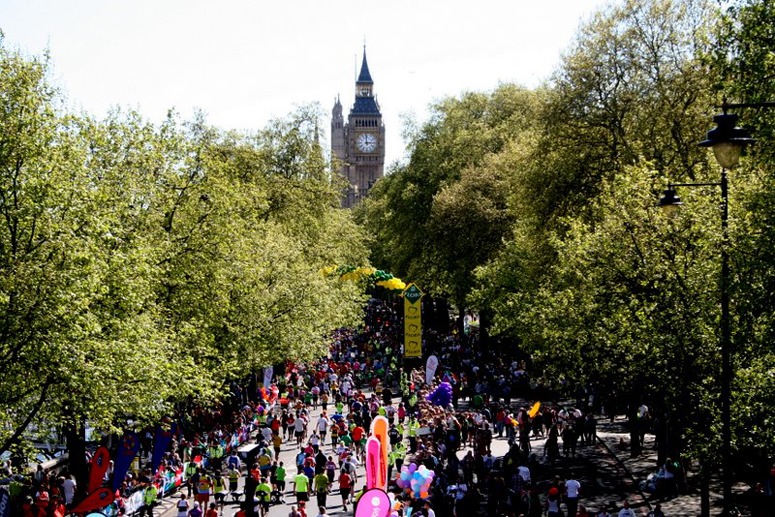 Cities need good routes for processions and should ask garden designers to help with them, because garden design has so often been the crucible for urban design. The magnificent route in this photograph is shown on 26th April 2009 being used for the London Marathon. The route is on the north bank of the River Thames, with Big Ben in the background, and is one of the most comprehensive urban design projects London has ever seen. Most days of the year the place is made wretched by heavy traffic. But when closed for processions it is a wonder – which should be made permanent because, as Jane Jacobs remarked, urban designers should plan for the attrition of automobiles by cities. The land shown in the photograph was ‘reclaimed’ (ie stolen) from private gardens and from the River Thames. The project was designed by an engineer, Sir Joseph Bazalgette, and begun in 1862. It includes a low level interceptor sewer, an underground railway, a wide road and a retaining wall built with Cornish granite.
Cities need good routes for processions and should ask garden designers to help with them, because garden design has so often been the crucible for urban design. The magnificent route in this photograph is shown on 26th April 2009 being used for the London Marathon. The route is on the north bank of the River Thames, with Big Ben in the background, and is one of the most comprehensive urban design projects London has ever seen. Most days of the year the place is made wretched by heavy traffic. But when closed for processions it is a wonder – which should be made permanent because, as Jane Jacobs remarked, urban designers should plan for the attrition of automobiles by cities. The land shown in the photograph was ‘reclaimed’ (ie stolen) from private gardens and from the River Thames. The project was designed by an engineer, Sir Joseph Bazalgette, and begun in 1862. It includes a low level interceptor sewer, an underground railway, a wide road and a retaining wall built with Cornish granite.
Wiki has the following definition: ‘A procession (via Middle English processioun, French procession, derived from Latin, processio, itself from procedere, to go forth, advance, proceed) is, in general, an organized body of people advancing in a formal or ceremonial manner.’

This delimma highlights the pros and cons of professional specialisation within the built environment. Each profession has a unique set of concerns about which it is said to have specialised knowledge – yet the environment is not such a discrete entity. It seems there is a need both to maintain individual professional identities while also building bridges to a larger conversation and ways of seeing. This mandate is particularly important for sustainability and for enhancing the quality of our cities.
Any ideas on how autonomy can be preserved and collaboration fostered?
I quote from an article by an environmental designer in ‘Archi’ (Dec 2001 p8)
“One of the fundamental differences between how architects and designers work is the idea of collaboration. On a daily basis, I work with people from a variety of backgrounds: from designers to theatre majors to thespians. We each have a unique way to approach a project, and each is valid. One person will come up with an idea and another will take it and expand upon it, and the cycle continues. There are few egos involved through this type of collaboration, and it creates a truly team atmosphere.”
Perhaps the urban design profession because it is composed of people from many different foundation disciplines is uniquely placed to address this issue? It would be interesting to hear antedotes of both the frustrations and joys of interdisciplinary collaboration….
My solution is that we should retain our professional specializations but that we should ALL become urban designers, rather as we should all learn ‘reading, writing and arithmetic’ at school. The ‘three Rs’ of urban design (I don’t have r-words for them) should relate to social context, ecological context and aesthetic context. They derive, of course, from Vitruvius’ utilitas, firmitas and venustas (very badly translated into English, by Henry Wotton, as Commodity, Firmness and Delight).
I have recently come across an interesting book by climate researcher Richard Alley ‘The two mile time machine'(2000).
It seems abrupt climate change is not unusual. According to Alley “…the last ice age came and went in a drunken stagger, punctuated by dozens of abrupt warmings and coolings.” (p5) He says the best known of the abrupt climate changes is the ‘Younger Dryas Event’ (at its
end Greenland warmed by 15 degrees in a decade or less).
It is his opinion that if we can slow down human induced global warming “it is just possible that we can avoid abrupt climate change and even help stabilise the climate.”
Do you think this might be a worthwhile interdisciplinary read to found a debate on climate change [ecological context]?
I think climate change worries are best treated as a ‘marketing opportunity’. We should use the widespread concern to persuade people to do what they should be doing anyway (eg using less fossil fuel). Whether or not the worry has a firm foundation is irrelevant from this point of view.
An interesting point about the Younger Dryas is that archaeologists regard it as one of the possible reasons for the Neolithic Revolution, in which farming began. As to whether farming was a good or a bad thing for the future of Homo sapiens sapiens remains to be seen!
Gosh! Interesting to ask this question too from the perspective of Indigenous Australia….
‘To garden or not to garden that is the question?’
This time in history IS certainly presenting all the big questions!!